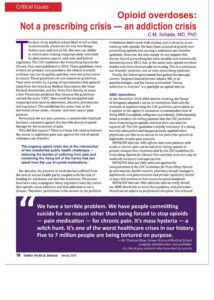The dean of my medical school liked to tell us that, fundamentally, physicians do only two things: Relieve pain and extend life. But now our ability to relieve pain is being inappropriately restricted by pharmacists, payors, and state and federal regulators. The CDC Guidelines for Prescribing Opioids for Chronic Pain were published in 2016. These guidelines were written for primary care providers, the clinical scientific evidence was low in quality, and they were not prescriptive
in nature. These guidelines are not consensus guidelines. They were written by a group of opioidphobes that ignored input from the American Medical Association, the Texas Medical Association, and the Texas Pain Society, to name a few. Physicians predicted that, because the guidelines carried the name “CDC,” they would be misapplied and inappropriately used by physicians, insurers, pharmacists, and regulators. This prediction has come true, to the detriment of our acute-, chronic- and even cancer-pain patients.
Fortunately for our pain patients, a considerable backlash has been unleashed against this horrible denial of opioid therapy for the treatment of pain. Why did this happen? There is a bona fide need to balance the access to legitimate pain care against the risk of opioid substance use disorder.
The ongoing opioid crisis lies at the intersection of two substantial public health challenges — reducing the burden of suffering from pain and containing the rising toll of the harms that can result from the use of opioid medications.
You can read the full article here: Dallas_Medical_Journal_January_2019

